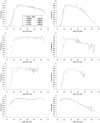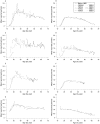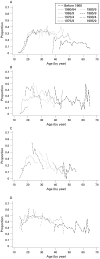Reported number of sexual partners: comparison of data from four African longitudinal studies
- PMID: 19307344
- PMCID: PMC2654146
- DOI: 10.1136/sti.2008.033985
Reported number of sexual partners: comparison of data from four African longitudinal studies
Abstract
Objective: To compare reported numbers of sexual partners in Eastern and Southern Africa.
Methods: Sexual partnership data from four longitudinal population-based surveys (1998-2007) in Zimbabwe, Uganda and South Africa were aggregated and overall proportions reporting more than one lifetime sexual partner calculated. A lexis-style table was used to illustrate the average lifetime sexual partners by site, sex, age group and birth cohort. The male-to-female ratio of mean number of partnerships in the last 12 months was calculated by site and survey. For each single year of age, the proportion sexually active in the past year, the mean number of partners in the past year and the proportion with more than one partner in the past year were calculated.
Results: Over 90% of men and women between 25 and 45 years of age reported being sexually active during the past 12 months, with most reporting at least one sexual partner. Overall, men reported higher numbers of lifetime sexual partners and partners in the last year than women. The male-to-female ratio of mean partnerships in the last year ranged from 1.41 to 1.86. In southern African cohorts, individuals in later birth cohorts reported fewer sexual partners and a lower proportion reported multiple partnerships compared with earlier birth cohorts, whereas these behavioural changes were not observed in the Ugandan cohorts. Across the four sites, reports of sexual partnerships followed a similar pattern for each sex.
Conclusions: The longitudinal results show that reductions in the number of partnerships were more evident in southern Africa than in Uganda.
Conflict of interest statement
Figures



References
-
- Aral SO. Sexual behaviour in sexually transmitted disease research. Sex Transm Dis 1994;21Suppl:S59–64 - PubMed
-
- Cleland J, Ferry B, ed. Sexual behaviour and AIDS in the developing world London: Taylor and Francis, 1995
-
- Wellings K, Collumbien M, Slaymaker E, et al. Sexual behaviour in context: a global perspective. Lancet 2006;368:1706–28 - PubMed
-
- Ferry B, Carael M, Buve A, et al. Comparison of key parameters of sexual behaviour in four African urban populations with different levels of HIV infection. AIDS 2001;15(Suppl 4):S41–50 - PubMed
-
- Stoneburner RL, Low-Beer D. Population-level HIV declines and behavioral risk avoidance in Uganda. Science 2004;304:714–8 - PubMed
Publication types
MeSH terms
Grants and funding
LinkOut - more resources
Full Text Sources
Miscellaneous
